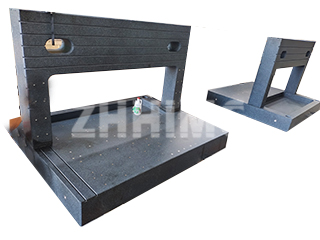Granite, known for its exceptional hardness, durability, and aesthetic appeal, has been widely used not only as a decorative material but also as a structural component in precision and architectural applications. In modern structural design, how to improve structural efficiency through the optimization of the cross-sectional shape of granite beams has become a topic of growing importance, particularly as industries pursue both lightweight structures and superior mechanical performance.
As one of the primary load-bearing elements in architecture and precision equipment bases, the cross-sectional design of a granite beam directly influences its load-bearing capacity, self-weight, and material utilization. Traditional cross-sections—such as rectangular or I-shaped forms—have long met basic structural requirements. However, with the advancement of computational mechanics and the increasing demand for efficiency, optimizing these cross-sectional shapes has become essential to achieve higher performance without unnecessary material consumption.
From a structural mechanics standpoint, an ideal granite beam cross-section should provide sufficient stiffness and strength while minimizing material usage. This can be realized through optimized geometry that ensures a more uniform stress distribution and allows full utilization of granite’s high compressive and bending strength. For example, adopting a variable cross-section design, where the beam has larger sections at areas of higher bending moment and narrower sections where stresses are lower, can effectively reduce overall weight while maintaining structural integrity.
Modern finite element analysis (FEA) tools now make it possible to simulate various cross-sectional geometries and loading conditions with remarkable accuracy. Through numerical optimization, engineers can analyze stress-strain behaviors, identify inefficiencies in the original design, and fine-tune parameters to achieve a more efficient structure. Research has shown that T-shaped or box-shaped granite beam sections can effectively distribute concentrated loads and improve rigidity while reducing mass—a significant advantage in both construction and precision equipment frameworks.
In addition to mechanical performance, granite’s natural texture and visual elegance also make it a material that bridges engineering and aesthetics. Optimized cross-sectional forms—such as streamlined or hyperbolic geometries—not only enhance load-bearing efficiency but also introduce unique visual appeal. In architectural design, these shapes contribute to modern aesthetics while maintaining the mechanical precision and stability for which granite is renowned.
The integration of engineering mechanics, materials science, and computational modeling enables designers to push the limits of what granite can achieve as a structural material. As simulation technology advances, engineers can explore unconventional geometries and composite structures that balance mechanical efficiency, stability, and visual harmony.
In conclusion, optimizing the cross-sectional shape of granite beams represents a powerful approach to improving structural efficiency and sustainability. It allows for reduced material usage, enhanced strength-to-weight ratios, and improved long-term performance—all while maintaining the natural elegance of granite. As the demand for high-precision and aesthetically refined structures continues to grow, granite, with its exceptional physical properties and timeless beauty, will remain a key material in the development of next-generation structural and industrial designs.
Post time: Nov-13-2025

